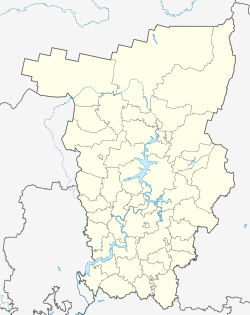Solikamsk
| city
Solikamsk
Соликамск
|
||||||||||||||||||||||||||||||||||||||||||
|
||||||||||||||||||||||||||||||||||||||||||
|
||||||||||||||||||||||||||||||||||||||||||
| List of cities in Russia | ||||||||||||||||||||||||||||||||||||||||||
Solikamsk ( Russian Соликамск ) is one of the oldest cities in the Russian Perm region .
With 97,384 inhabitants (14 October 2010) is the city behind Perm and Berezniki 's third largest city of the region and occupies an area of 165.50 square kilometers one. The city's name comes from sol (Russian for ' salt ') and the Kama River .
location
Solikamsk is located in the northern part of Perm Oblast on the Kama, 368 kilometers from the regional capital Perm. The closest cities are Berezniki and Ussolje , both 20 km south of Solikamsk. Due to the many and large industrial companies, especially the Magnesium Combine, the surroundings of the city, the forests, the air and the Kama are heavily polluted.
history

Solikamsk was mentioned for the first time in 1430 and was initially named Usolje-na-Kamskom in connection with the discovery of the huge salt deposits . This place was founded on a holy place of the Komi-Permyaks and near one of their villages. The favorable geographical location and rich salt deposits quickly attracted many traders. In 1573 Ussolye received city rights and during the 17th century (when it got its new name) it developed into the salt capital of Russia and the sole center of the Kama region. It was a large and important junction on the way to Siberia and generated more than half of Russia's total salt yield.
A new phase of development began after the October Revolution , when the world's largest potash and magnesium salt deposits were discovered in 1925 . In 1927, construction began on the Soviet Union's first potassium combine . After the opening of the Potash Salt Combine in 1928, a Magnesium Combine followed in 1938 and a large paper mill in 1941 . In the second half of the century, the newly created industrial center burst its limits, initially in 1959 when the city of Borovsk (not to be confused with the city of the same name in central Russia) was incorporated and in the 1980s when the new residential areas also extended to the valley of the Klestowka expanded.
In the incorporated city of Borowsk, there was a POW camp 366 for German POWs from World War II .
Population development
| year | Residents | comment |
|---|---|---|
| 1897 | 4,073 | |
| 1939 | 33,722 | and 4,349 inhabitants in the Borowsk workers' settlement (incorporated in 1959) |
| 1959 | 82,874 | |
| 1970 | 88,595 | |
| 1979 | 101.158 | |
| 1989 | 110,098 | |
| 2002 | 102,531 | |
| 2010 | 97.384 |
Note: census data
economy
Solikamsk is the headquarters of Uralkali . The largest shareholder in Uralkali is the Russian financial investor Suleiman Kerimow .
population
Since the political upheaval in 1991, the population of Solikamsk, as in many other parts of Russia, has been falling. Children up to the age of 15 make up 25.6% of the population, people of retirement age 14.8%, and 59.6% who are able to work. 89% of the city's population are Russians, Ukrainians 1.9%, Tatars 1.4%.
sons and daughters of the town
- Witali Grossmann (1963–2005), ice hockey player
- Stepan Sannikow (* 1990), ice hockey player
- Ekaterina Shumilova (* 1986), biathlete
- Irina Uslugina (* 1988), biathlete
- The Latvian journalist Richards Bērziņš (born December 26, 1888; writer pseudonym: Rihards or Richards Valdess, novel “Tarjacken”, translated by Oskar Grosberg ), who was deported from Ikšķile to Solikamsk on June 14, 1941, found his way here on February 20, 1942 death at the age of 53.
See also
Web links
- Solikamsk on mojgorod.ru (Russian)
- Unofficial portal of the city (Russian)
Individual evidence
- ↑ a b Itogi Vserossijskoj perepisi naselenija 2010 goda. Tom 1. Čislennostʹ i razmeščenie naselenija (Results of the All-Russian Census 2010. Volume 1. Number and distribution of the population). Tables 5 , pp. 12-209; 11 , pp. 312–979 (download from the website of the Federal Service for State Statistics of the Russian Federation)
- ↑ Maschke, Erich (Ed.): On the history of the German prisoners of war of the Second World War. Verlag Ernst and Werner Gieseking, Bielefeld 1962–1977.
- ↑ Lucrative potash mining in the Urals in: FAZ of October 10, 2011, page 18



